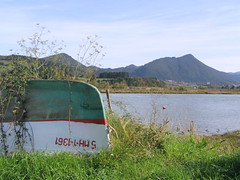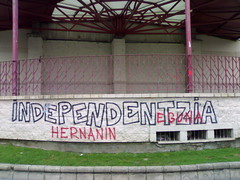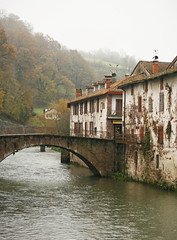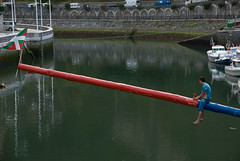Today the international community celebrates the 6oth anniversary of the
Universal Declaration of Human Rights by the UN. It has been 60 years in which both Spain and France have institutionally violated the rights of the Basque people. They have been able to do this only because they count with the silent complicity of many other countries.
Even worst, both Spain and France have created a special status quo for Euskal Herria that is tantamount to the Apartheid regime in South Africa, something that not even Nadine Gordimer has the guts to point out.
But not only Nadine Gordimer has excused the colonial occupation of Euskal Herria by Spain and France by declaring the the Basques do not have the right to be independent (in clear disregard to the
International Covenant on Civil and Political Rights), also the main force behind Kosovo's independence, Martti Ahtisaari, has make public statements against the Basque right to self determination.
This is why I invite you to read this article published at Balkan Insight:
Balkan Earthquake is Felt Far Away
By Darko Duridanski in Skopje, Tbilisi, Sukhumi, Vitoria, Bilbao and Pristina
08 December 2008
From the Basque country to the Caucasus, the implications of the former Serbian province’s march to independence are being followed - and debated.
As jubilant Kosovars danced in front of the Newborn statue unveiled in the capital, Pristina, to commemorate their long-awaited independence on February 17, 2008, many political leaders around the world watched the events with different emotions.
Their core concern was that granting independence to a former province could boost secessionist movements the world over, and not turn out to be a sui generis case, as Kosovo’s European backers have insisted.
The debate over the “Kosovo precedent” was revived in August 2008, when Russian forces poured into the breakaway Georgian regions of Abkhazia and South Ossetia. The conflict ended in Russia’s recognition of the enclaves’ independence, and the example of Kosovo as justification for this.
“We argued consistently that it would be impossible to tell the Abkhazians and Ossetians that what was good for the Kosovo Albanians was not good for them,” the Russian President, Dmitry Medvedev, wrote on August 27, 2008, in the Financial Times.
Advocates for the self-determination of various regions and provinces echo those sentiments. Some surveys estimate that there are over 200 secessionist movements worldwide.
Some of the most significant are in Europe. In Britain, there are Scottish and Welsh independence movements and the movement to unite Northern Ireland with the Republic of Ireland. In Spain there are Catalan and Basque independence movements while in Greenland, many seek independence from Denmark. Then, there is the push by Turkish Northern Cyprus and Transdnistria, already de facto independent states, to gain international recognition of their separation from Cyprus and Moldova.
In the Caucasus, outside the aforementioned Georgian enclaves, an unresolved conflict simmers over the ethnic Armenian province of Nagorno Karabakh in Azerbaijan, while secessionist movements are active in the Russian republics of Chechnya and Dagestan. In China, there are the Tibetan and Uygur (Xinjiang) independence movements and in Africa, conflicts continue over the Western Sahara in Morocco, and South Sudan. Kurdish nationalism, meanwhile, involves several states – Turkey, Iraq and Syria.
However, after travelling to two very different lands in which there are strong secessionist movements, Abkhazia and the Basque Country, it seems for the time being, at least, that international fears about the impact of Kosovo’s independence are largely misplaced. Separatists are certainly interested in events in Kosovo and draw courage from them. But there is little evidence that Kosovo’s independence or recognition has significantly boosted their prospects of statehood.
If Kosovo has it, why not Abkhazia?
At the bridge over the river Ingur, the only entry point to Abkhazia from Georgia, stands a monument of a pistol with its barrel tied in a knot. Erected as a symbol of disarmament, it is a small version of the sculpture, Knotted Gun, by the Swedish artist Carl Fredrik Reutersward. It expresses the aspiration of all the residents of this unrecognised country for peace.
But real peace still eludes this troubled land. The battered streets of the capital, Sukhumi, evoke a country that emerged from war yesterday, though the fight against Georgia ended in 1993.
At both ends of the bridge, Russian soldiers - the architects and supporters of Abkhazian independence - wait in white armoured personnel carriers, watching the few people crossing the bridge. They keep the peace along the administrative border with Georgia, albeit to the dismay of the Georgians who do not regard them as honest brokers.
With a population of around 220,000, and recently recognised by Russia, Abkhazia sees Kosovo as a possible role model, despite the fact that Russia, a staunch ally of Serbia, has bitterly opposed Kosovo`s independence, warning it could have a domino effect around the world.
The Abkhazians do not compare their situation directly with Kosovo but use the “double-standards” argument to insist they are entitled to the same treatment. By this, they mean the Western claim that Kosovo’s recognition is a sui generis case, which cannot be applied elsewhere.
Following the break-up of the Soviet Union during which time they were autonomous republics inside Georgia, both Abkhazia and South Ossetia declared independence in 1992, triggering armed conflicts that ended in a Georgian withdrawal. Provisional peace agreements, brokered by Russia, resulted in the deployment of Russian forces along the administrative border with Georgia, enabling these lands to become de facto independent states, though without international recognition.
Kosovo was also an autonomous province until the Serbian leader Slobodan Milosevic stripped it of its autonomous status and incorporated it into Serbia in the early 1990s.
The government suppressed the rights of ethnic Albanians, triggering an armed conflict with a local guerrilla force, the Kosovo Liberation Army. This ended in June 1999 after NATO forced the Serbian police and army to withdraw.
Kosovo then became a UN-administered territory. But, crucially, Western political leaders agreed that any return to Serbian sovereignty was out of the question, prompting rapid recognition of Kosovo’s unilateral declaration of independence from Serbia.
Georgians resent comparison between their struggle to regain control over their lost provinces and Serbian tactics in Kosovo. “The independence of Kosovo has worried us, although these conflicts are different and the reasons behind them are different,” says Alexander Rondeli, of the Georgian Foundation for Strategic and International Studies, in Tbilisi. “In Kosovo we saw the extremist measures of the Serbs towards the Albanians but in Abkhazia the Georgians have been the victims of ethnic cleansing,” he adds, referring to the several hundred thousand Georgian refugees from Abkhazia in the 1990s.
Temur Iakobashvili, Georgia’s Minister of Reintegration, makes the same point. “I don’t see similarities between Kosovo and Abkhazia, these are different conflicts,” he says. “The Kosovars were subject to ethnic cleansing, and here, this is the case with the Georgians, which is a significant factor.”
Diana Chachua, 22, a Georgian refugee from Abkhazia, remembers the day Kosovo proclaimed independence with pain. “I knew it was bound to happen but was still shocked,” she recalls. Georgians rarely travel to Abkhazia these days, she adds. “It is only Abkhazians that travel across the bridge.”
Since Kosovo’s independence, Russia has strengthened its ties with South Ossetia and Abkhazia, abolishing border controls and granting many locals Russian passports. Their currency is the rouble.
Vjacheslav Chirikba, a foreign policy adviser to the Abkhazian President, Sergey Bagapsh, says if Kosovo is entitled to statehood, so is Abkhazia. During the early years of the USSR it was a separate Soviet republic, he notes, and now it meets all the criteria for a recognised state. “Both main factors are met, political and state structure, plus economic sustainability, so where is the problem?” Chirikba asks. “Abkhazia will never be a part of Georgia,” concurs Maxim Gvindzhia, Abkhazian Deputy Foreign Minister. “Independence for us, as in the case of Kosovo, is an issue of self-preservation. Independence is the only guarantee of the preservation of our nation.”
While both Georgians and Abkhazians draw parallels between their situation and Serbia-plus-Kosovo, few outside experts believe events in Kosovo exerted any concrete effect on the Caucasus, or triggered the war in South Ossetia.
The five-day war in South Ossetia started when Georgia tried to retake control of the region on August 8, 2008. The move by Georgia`s president, Mikhail Saakashvili, triggered a fierce military response by Russia which sent troops to Georgia under the pretext of preventing genocide.
Tim Judah, an expert on both the Balkans and the Caucasus, says the conflict was inevitable, regardless of Kosovo’s declaration of independence.
“Even if Kosovo hadn’t existed, the conflict in South Ossetia would not have been avoided,” he says. “Russia is naturally very interested in using Kosovo as an argument. But Russia is not really interested in South Ossetia or Abkhazia, it is more interested in preventing Georgia from joining NATO.”
George Hewitt, Professor of Caucasian languages at the London School of Oriental and African Studies, SOAS, agrees. “I don’t attribute any upsurge in activity here in the Caucasus to what happened in Kosovo,” he says. “Events in South Ossetia can be more readily explained by NATO’s folly in Bucharest,” he adds, referring to the 2008 summit at which Georgia’s appeal for membership was rejected.
A model for the Basques?
While Abkhazians – and Armenians in Nagorny Karabakh – mull the dilemma of enjoying de facto but not de jure independence, the Basques face a very different challenge: how to peacefully convert their existing regional autonomy to full statehood inside a developed Western democracy.
Despite the terrorist attacks launched by the Basque independence movement, ETA, over the past 40 years, most Basque people now see peaceful talks as the only path to independence.
They welcome Kosovo’s independence. Iratze Urizar, who works in Bilbao for an organisation that helps Basques in Spanish jails, says Basque nationalists viewed the events in Kosovo as affirmation of the principle of self-determination. “People here were happy for Kosovo,” she says. “What connects us is the right to self-determination.”
Historically, the Basque Country comprises seven provinces, four in Spain and three in France. Although the nationalist movement is spread over all seven, it is stronger in the three provinces in Spain, Alava, Biscay and Guipuscoa, which form the Basque Autonomous Country.
The autonomous Basque government proposed a referendum that would have paved the way for a referendum on independence, planned for 2010. However, the central government in Madrid strongly opposed the plan and Spain’s highest court in mid-September ruled the referendum unconstitutional. The conflict between Madrid and the Basques over the referendum coincides with a similar conflict over Kosovo: the Basque government supports Kosovo’s independence, while Madrid does not.
According to the Basque President, Juan Jose Ibarretxe, events in Kosovo show the right of nations’ to self-determination cannot now be denied. “The 21st century is the century of identity and nations; it is the century of respect for the will of the people,” he said in February, following Kosovo’s declaration of independence.
A survey by the Basque government claims that 78 per cent of Basques want the referendum to go ahead. They believe the process of self-determination has started, and that there is no turning back.
“In an age of globalisation, small nations must become independent in order to defend their sovereignty,” says Urko Aiartza Azurtza, a lawyer for Batasuna, a hardline Basque nationalist party that the Spanish government has banned. “It’s a process that has started and cannot be stopped.”
The Spanish government, on the other hand, steadfastly refuses to recognise Kosovo’s independence, one of five remaining EU refuseniks – alongside Romania, Slovakia, Greece and Cyprus. The government also denies most Basques support independence, saying only 30 per cent want it.
Aitor Esteban, deputy of the Basque Nationalist Party in the Spanish parliament, is not surprised by Madrid’s position. “It is a contradiction because if Kosovo is indeed an exception or ‘a unique case’, it should not represent a problem,” he says. “But, actually, they [the Spanish government] think this will not be the last such case, and that many other ‘hot’ issues over nationalities will now open up in Western Europe.”
The criteria for statehood is unclear
Back in Kosovo, whose independence had been recognised by 52 states at the time of writing, ordinary people are aware their struggle has stirred hopes among other small nations that feel occupied, repressed or enslaved. “I fully support those initiatives for independence that look to Kosovo, those nations striving for independence that are truly repressed and seek liberation,” says Agon Hamza, a law graduate in Pristina.
But while ordinary people sympathise with liberation movements, Kosovo leaders refuse to let their country become a standard-bearer for other liberation movements. “We have always stressed that Kosovo has special characteristics,” Kosovo’s President, Fatmir Sejdiu, has said. “It is a case sui generis and cannot be used as a precedent for other conflict zones, areas or regions.”
Experts in Kosovo are more nuanced, saying it is hard to define the standards by which a nation has a right to break away and start an independent existence.
One local NGO, the Kosovar Institute for Policy Research and Development, KIPRED, in a study released late last year, lists several criteria. These include borders established in the previous system before the dissolution of the state, the presence of an ethnic minority subjected to ethnic cleansing or serious violation of minority rights, and the existence of democratic structures recognised by the international community.
By applying these tests, Albanians in neighbouring Macedonia, for example, seem unlikely to win their own state. This is despite the existence of a strong secessionist movement dating from the early 1990s, and an armed conflict that erupted in 2001, pitting the security forces against Albanian guerrillas claiming to represent the 25 per cent minority.
Since then, however, Macedonia has moved back from the brink and been praised for its management of minority issues. Following an internationally-brokered peace deal signed in Ohrid in 2001, fighting has ended, minority rights have improved, and the wind’s been taken out of the sails of the separatist campaign.
But while Macedonia no longer sees independence for Kosovo as a direct threat - Skopje recently recognised the Pristina government - there are still fears in Macedonia that an ethnic division of Kosovo (if the Serb-dominated north secedes) could inspire Macedonian Albanians in the west of the country to follow suit.
“In the short term, there is no danger of instability spilling over from Kosovo into Macedonia,” Biljana Vankovska, pofessor of political science and defence at the Cyril and Methodius University in Skopje, says. “But any continued regional fragmentation, such as the division of Kosovo, or the separation of the Republika Srpska from Bosnia, may shift the tectonic plates. Many things will depend on the interests of the US and Russia in the region.”
As a result, Macedonian officials counsel against the redrawing of borders in Kosovo or Bosnia, fearing an impact down the line in Macedonia. After all, Kosovo may once again serve as an alibi.
“The West has demonstrated its ethical foreign policy in Kosovo and today, Russia is doing the same in the Caucasus,” Vankovska notes. “This is leading us into an insecure world in which all issues may be settled on the principle that ‘If this can be done here, why not there as well? Why should we be a minority in your state when you can be minority in ours?’”
Professor Hewitt says in the final analysis such cases cannot be judged solely from the point of view of international law: the moral aspect of the case for independence must be included.
“If a country by its actions loses the moral right to control this or that region, which may or may not be populated by an ethnic minority, then that region or ethnic minority has the right to press its case for self-determination,” he says. “Some laws are there to be broken.”
And then again you have spineless cowards like Fatmir Sejdiu who knowing very well that Kosovo does not meet the criteria to be an independent state and that it got there thanks to the USA involvement in the area goes on to declare that other nations do not deserve their statehood because Kosovo is a
sui generis case (does he sound like Basque-phobe Martti Ahtisaari or what?). So, instead of having new nations showing solidarity and sympathy towards those who have been experiencing similiar libertation struggles we get even more people disregarding the right of entire nations to their self determination.
This is the biased world in which we celebrate the 60th anniversary of the Human Rights declaration.
.... ... .
BILBAO, Spain (AFP) — Thousands of people marched through the northern Spanish city of Bilbao Saturday to demand the Basque football team be allowed to take part in international competitions.






